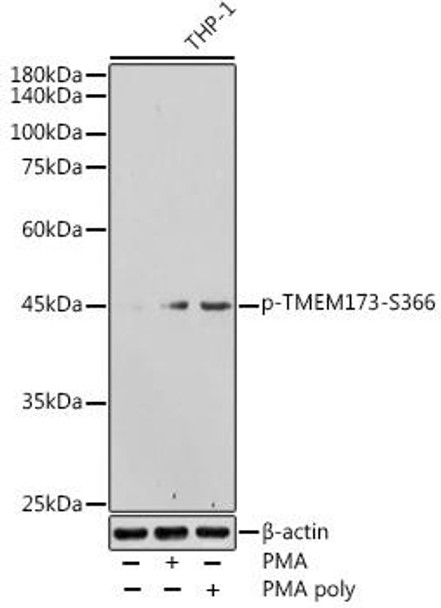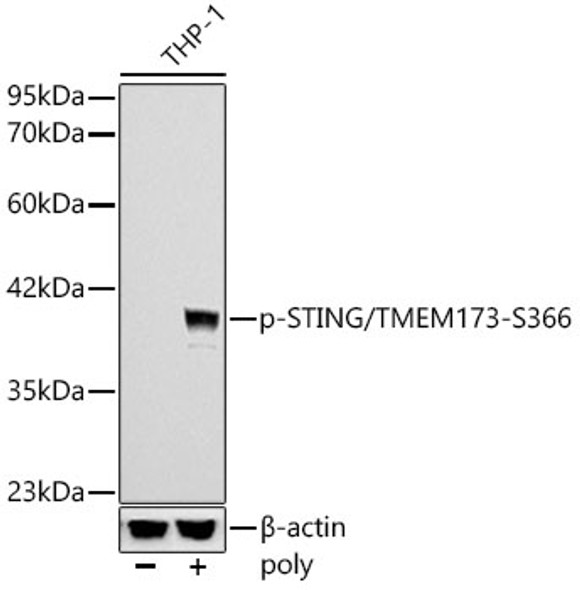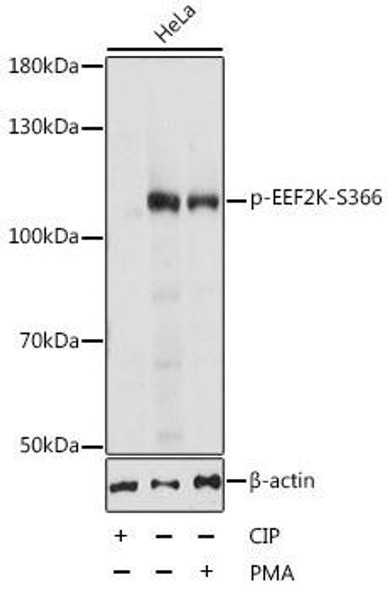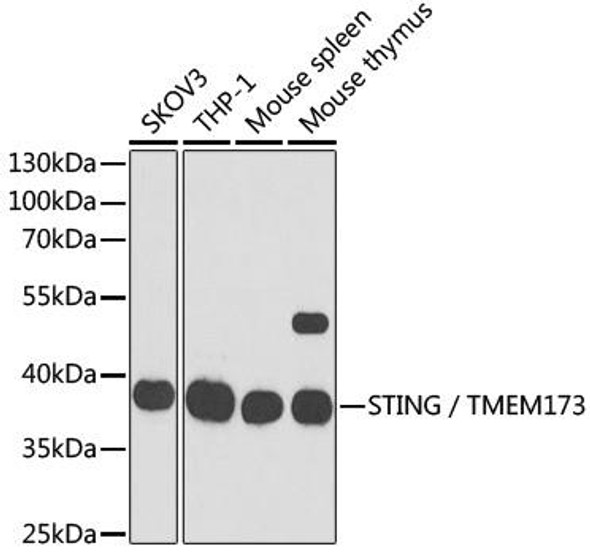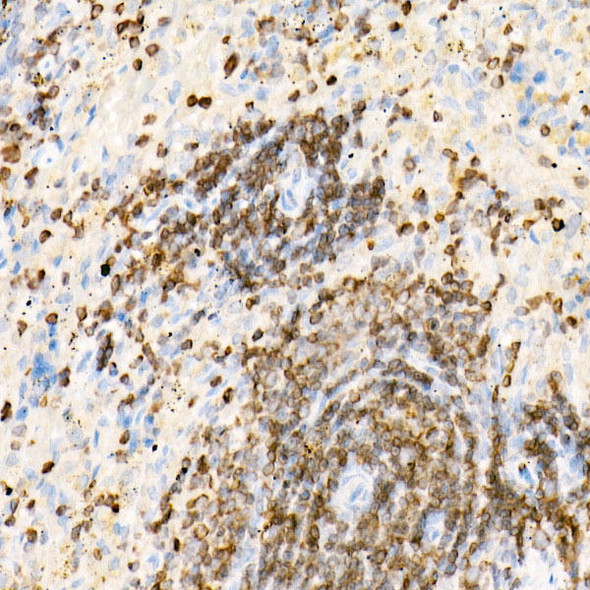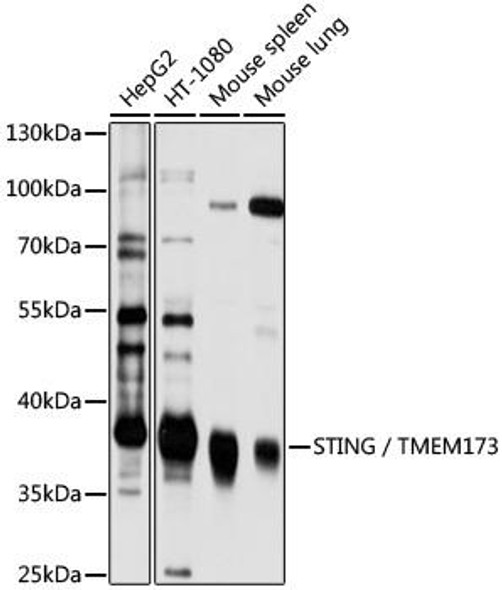Anti-Phospho-TMEM173-S366 Antibody (CABP1223)
- SKU:
- CABP1223
- Product Type:
- Antibody
- Antibody Type:
- Polyclonal Antibody
- Reactivity:
- Human
- Reactivity:
- Mouse
- Reactivity:
- Rat
- Host Species:
- Rabbit
- Isotype:
- IgG
- Synonyms:
- TMEM173
- Synonyms:
- ERIS
- Synonyms:
- MITA
- Synonyms:
- MPYS
- Synonyms:
- NET23
- Synonyms:
- SAVI
- Synonyms:
- STING
- Synonyms:
- hMITA
- Synonyms:
- hSTING
- Research Area:
- Autophagy
Description
| Product Name: | Phospho-TMEM173-S366 Rabbit pAb |
| Product Code: | CABP1223 |
| Size: | 50uL, 100uL |
| Synonyms: | TMEM173, ERIS, MITA, MPYS, NET23, SAVI, STING, hMITA, hSTING |
| Applications: | WB |
| Reactivity: | Human, Mouse, Rat |
| Host Species: | Rabbit |
| Immunogen: | A phospho specific peptide corresponding to residues surrounding S366 of human TMEM173. |
| Applications: | WB |
| Recommended Dilutions: | WB 1:500 - 1:2000 |
| Reactivity: | Human, Mouse, Rat |
| Positive Samples: | THP-1 |
| Immunogen: | A phospho specific peptide corresponding to residues surrounding S366 of human TMEM173. |
| Purification Method: | Affinity purification |
| Storage: | Store at -20°C. Avoid freeze / thaw cycles. Buffer: PBS with 0.02% sodium azide, 50% glycerol, pH7.3. |
| Isotype: | IgG |
| Sequence: | Email for sequence |
| Gene ID: | 340061 |
| Uniprot: | Q86WV6 |
| Observed MW: | 41KDa |
| UniProt Protein Function: | TMEM173: Facilitator of innate immune signaling that promotes the production of type I interferon (IFN-alpha and IFN-beta). Innate immune response is triggered in response to non-CpG double- stranded DNA from viruses and bacteria delivered to the cytoplasm. Able to activate both NF-kappa-B and IRF3 transcription pathways to induce expression of type I interferon and exert a potent anti- viral state following expression. May be involved in translocon function, the translocon possibly being able to influence the induction of type I interferons. May be involved in transduction of apoptotic signals via its association with the major histocompatibility complex class II (MHC-II). Mediates death signaling via activation of the extracellular signal-regulated kinase (ERK) pathway. Associates with the MHC-II complex. Homodimer; 'Lys-63'-linked ubiquitination at Lys-150 is required for homodimerization. Interacts with DDX58/RIG-I, MAVS/VISA and SSR2. Interacts with RNF5 and TRIM56. Interacts with TBK1; when homodimer, leading to subsequent production of IFN-beta. Ubiquitously expressed. Belongs to the TMEM173 family. |
| UniProt Protein Details: | Protein type:Mitochondrial; Membrane protein, multi-pass; Apoptosis; Membrane protein, integral; Endoplasmic reticulum Chromosomal Location of Human Ortholog: 5q31.2 Cellular Component: Golgi apparatus; endoplasmic reticulum membrane; mitochondrial outer membrane; cytoplasmic vesicle membrane; perinuclear region of cytoplasm; plasma membrane; integral to membrane; peroxisome Molecular Function:identical protein binding; protein binding; protein homodimerization activity; ubiquitin protein ligase binding; transcription factor binding; protein kinase binding Biological Process: regulation of interferon type I production; positive regulation of protein binding; positive regulation of protein import into nucleus, translocation; apoptosis; positive regulation of interferon type I production; positive regulation of transcription factor import into nucleus; innate immune response; positive regulation of transcription from RNA polymerase II promoter; positive regulation of defense response to virus by host; activation of innate immune response; defense response to virus; interferon-beta production Disease: Sting-associated Vasculopathy, Infantile-onset |
| NCBI Summary: | This gene encodes a five transmembrane protein that functions as a major regulator of the innate immune response to viral and bacterial infections. The encoded protein is a pattern recognition receptor that detects cytosolic nucleic acids and transmits signals that activate type I interferon responses. The encoded protein has also been shown to play a role in apoptotic signaling by associating with type II major histocompatibility complex. Mutations in this gene are the cause of infantile-onset STING-associated vasculopathy. Alternate splicing results in multiple transcript variants. [provided by RefSeq, Sep 2014] |
| UniProt Code: | Q86WV6 |
| NCBI GenInfo Identifier: | 74727720 |
| NCBI Gene ID: | 340061 |
| NCBI Accession: | Q86WV6.1 |
| UniProt Secondary Accession: | Q86WV6,A8K3P6, B6EB35, D6RBX0, D6RE01, D6RID9, |
| UniProt Related Accession: | Q86WV6 |
| Molecular Weight: | Observed MW: 39kDa; Calculated MW 42kDa |
| NCBI Full Name: | Stimulator of interferon genes protein |
| NCBI Synonym Full Names: | transmembrane protein 173 |
| NCBI Official Symbol: | TMEM173 |
| NCBI Official Synonym Symbols: | ERIS; MITA; MPYS; SAVI; NET23; STING; hMITA; hSTING |
| NCBI Protein Information: | stimulator of interferon genes protein; endoplasmic reticulum IFN stimulator; mitochondrial mediator of IRF3 activation; endoplasmic reticulum interferon stimulator; N-terminal methionine-proline-tyrosine-serine plasma membrane tetraspanner |
| UniProt Protein Name: | Stimulator of interferon genes protein |
| UniProt Synonym Protein Names: | Endoplasmic reticulum interferon stimulator; ERIS; Mediator of IRF3 activation; hMITA; Transmembrane protein 173 |
| Protein Family: | Stimulator of interferon genes protein |
| UniProt Gene Name: | TMEM173 |
| UniProt Entry Name: | STING_HUMAN |

